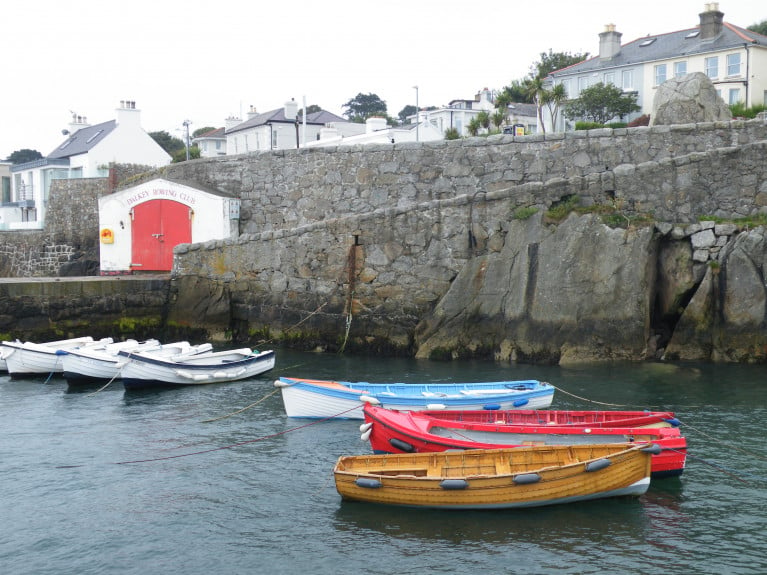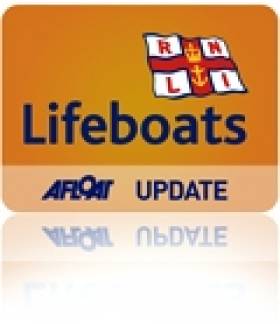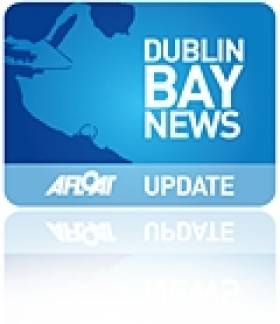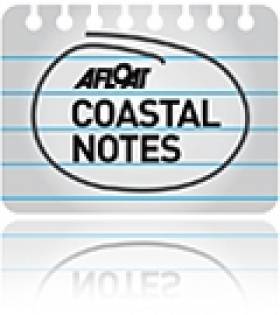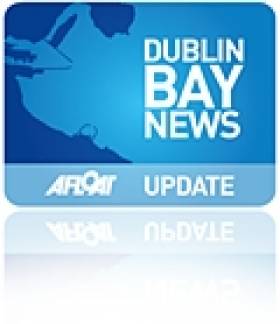Displaying items by tag: coliemore harbour
Ringsend and Dalkey Pay Respects to Late Ken ‘The Boatman’ Cunningham
Ringsend residents lined the streets of the south Dublin village to pay respects to the late Ken Cunningham following his funeral Mass on Saturday (3 February).
For many years Ken ran the passenger ferry, Licence No 1877, from Coliemore Harbour to Dalkey Island and made such an impact on the local community that Coliemore became affectionately known as “Ken’s Harbour”.
Ken was also an accomplished rower — unsurprising as he was one of the storied Cunninghams of Dalkey and East Coast rowing renown — and was a member of both Dalkey Rowing Club and St Patrick’s Rowing Club in Ringsend, which was his home in later years and where he leaves a lasting legacy.
Among those paying tribute on social media were Dakley Tidy Towns, who described Ken as “fund of knowledge and information on our surrounding waters”.
 Members of St Patrick’s Rowing Club form a guard of honour outside St Patrick’s Church in Ringsend at the funeral Mass for Ken Cunningham on Saturday 3 February
Members of St Patrick’s Rowing Club form a guard of honour outside St Patrick’s Church in Ringsend at the funeral Mass for Ken Cunningham on Saturday 3 February
Coastal Works in Dalkey, Co. Dublin Sees Completion of Coliemore Harbour Remedial Repair Project
Engineering works which took place over recent months in Dalkey, Co. Dublin involving the Coliemore Harbour Remedial Repair project have been completed this week, writes Jehan Ashmore.
A section of bedrock along the cliff face as Afloat reported in 2020, had collapsed into the water at the stone cut harbour which in medieval times was the port of Dublin. The small harbour is home to local boat users, a seasonal ferry boat service to Dalkey Island and the Dalkey Rowing Club.
The section of bedrock had been supporting the pathway leading to the southern pier which resulted in this part of the harbour to be temporarily closed. Prior to the engineering works starting in September, the ferry-boat service to Dalkey Island was able to operate this season operated by ‘Ken the Ferryman’ using the 12 passenger boat, Emma.
Afloat sought a comment on the project from Dun Laoghaire-Rathdown County Council (dlr) which are delighted to have completed the Coliemore Harbour Remedial Repair project.
A series of remedial options were considered and that planning permission was subsequently granted for the installation of a series of rock bolts anchored into the granite bedrock.
 The completed engineering works at Coliemore Harbour where rock-bolts have been anchored into the face of the bedrock, this permits access to the south pier via a pathway and above a public viewing area that has also been recently reopened Photo: DunLaoghaireRathdownCountyCouncil/Facebook
The completed engineering works at Coliemore Harbour where rock-bolts have been anchored into the face of the bedrock, this permits access to the south pier via a pathway and above a public viewing area that has also been recently reopened Photo: DunLaoghaireRathdownCountyCouncil/Facebook
The coastal engineering works, Afloat adds required the use of a crane to lower personnel to carry out works along the bedrock, noting the varying tidal conditions of the harbour. The large piece of dislodged bedrock that had fallen into the harbour was subsequently removed and is where a boom still remains in place.
The DLR have expressed thanks to their staff across departments for their invaluable contribution in delivering the scheme. In addition to Ove Arup, the lead consultant, and PJ Edwards as the main Contractor in successfully delivering the project in an environmentally constrained marine environment.
DLR also thank local stakeholders and users of the harbour for their support and accommodation in delivering the project.
The harbour project Afloat adds was co-funded by the Department of Agriculture, Food and the Marine, under the Fishery Harbour and Coastal Infrastructure Development Programme.
On completion of the project, this has also led to the reopening of the public plaza viewing area that overlooks the harbour on Coliemore Road.
Also sited here is a binocular-scope, donated by Dalkey Tidy Towns along with a plaque in memory and celebration of the late Dr. John de Courcy Ireland, the maritime historian who resided locally and is widely regarded as the father of ‘maritime’ Ireland.
Remedial Works Proposed for Coliemore Pier on Dublin Bay
Dún Laoghaire-Rathdown County Council has applied to An Bord Pleanála to carry out remedial works for a pier walkway in Coliemore Harbour which is a Protected Structure, located in Dalkey, on the southern shore of Dublin Bay.
The proposed development will comprise the mobilisation and site set-up, including access to a viewing platform and obstruction removal (bollards etc); removal of the temporary walkway to allow access for grouting.
The works include the installation of up to 16 rock anchors from the suspended platform via a crane located on the viewing platform and a resurfacing of the existing walkway.
As Afloat reported previously, €75,000 of funding was received for Coliemore Harbour repairs in 2021.
More on the DLRCoCo application is here
Dun Laoghaire Senator Sees Opportunity to Repair Bulloch & Coliemore Harbours Under New Grant Scheme
A Dun Laoghaire Senator has described this week's €35m Brexit Infrastructure Fund as an 'opportunity' for improvement of crumbling Dublin Bay Harbours.
Senator Barry Ward tweeted that both Coliemore and Bulloch Harbours in Dalkey County Dublin and Dun Laoghaire Harbour were all in need of 'urgent attention' in different ways.
Marine Minister Charlie McConalogue T.D., announced on Monday the new scheme to rejuvenate local authority public piers and harbours throughout coastal communities.
An opportunity for @dlrcc to address some of the infrastructural problems in #DúnLaoghaireHarbour, #Colliemore Harbour and #Bulloch Harbour? All in need of urgent attention in different ways.@Bullochharbour @DalkeyF @DalkeyRowing @DLMarina_Dublin @RowDunLaoghaire #Dalkey https://t.co/23IgpGngBB
— Barry Ward (@barrymward) January 25, 2022
Afloat previously reported in 2020 how the popular Dalkey Island seasonal ferryboat stopped service due to a partial collapse of a cliff-face underneath a footpath leading to the pier at Coliemore Harbour, Co. Dublin.
And in 2018, Bulloch Harbour's Bicencentary was against a backdrop of Storm Damage suffered in Storm Emma.
 Senator Barry Ward
Senator Barry Ward
Announcing the scheme, the Minister said this week “This record funding for our coastal communities is an unprecedented opportunity for us to invest in our publicly owned piers and harbours and will shape the future of our coastal communities. Brexit has and will continue to affect our seafood sector in a unique way compared to other industries. I am delighted to be able to offer this level of investment so that we can deliver safe, accessible, lasting infrastructure and support economic diversification right around our coastline.”
Dublin harbours are set to receive over €8.4m in funding for harbours in Fingal (Loughshinny Harbour, Skerries and Balbriggan Harbours) with Howth Harbour receiving €8.2m for specific improvements and two harbours in Dún Laoghaire-Rathdown County Council (Dún Laoghaire Harbour and Coliemore).
As Afloat reported earlier, the allocation of €38.3 million by Minister for the Marine, Charlie McConalogue TD is to repair, maintain and upgrade Ireland's publicly owned harbour network has been warmly welcomed.
Welcoming the announcement, Fianna Fáil Dublin Spokesperson Cormac Devlin TD (Dún Laoghaire) noted that funding of €75,000 for Coliemore Harbour in Dalkey and an allocation of €63,750 to install a pontoon in the Coal Harbour and upgrade facilities for local fishermen at Trader's Wharf in Dún Laoghaire Harbour were especially welcome.
Commenting, Deputy Devlin said "Coliemore Harbour is one of Ireland's oldest harbours dating back to the 13th century, when it was the leading port on the East Coast. The harbour has been in continuous use for hundreds of years, but was damaged by a rockfall in August 2020 and has been partially closed since. This funding will enable Dún Laoghaire - Rathdown County Council to carry out the estimated €100,000 works to repair and reopen the harbour."
Local Fianna Fáil councillor for Dalkey Justin Moylan commented "I am extremely grateful to my Party colleagues; Minister Charlie McConalogue and Deputy Cormac Devlin for their support for this important funding. Unfortunately having part of our harbour closed hampered the activities of local boatman, Ken The Ferryman as well as our award-winning Dalkey Rowing Club. Hopefully now with this funding they can all resume their activities for summer 2021"
The funding formed part of overall funding of €38.3m announced by Minister McConalogue who said, “This capital investment package in our 79 Local Authority owned piers and harbours around our coast which underlines the importance this Government places on the contribution of the wider seafood sector to Ireland’s economy and to rural coastal communities in particular.”
The Local Authority programme forms part of the Department of Agriculture, Food and the Marines’ 2021 Fishery Harbour and Coastal Infrastructure Development Programme, whereby the Department co-funds up to 75% of the total cost of approved projects with the Local Authority providing the balance.
In regard to the Local Authority scheme, the Minister stated, “It was important to me to place added importance on the Local Authority scheme this year and I am pleased to be to in a position to announce an enhanced €4.2 million programme in 2021 to assist Coastal Local Authorities in the repair and development of fishery and aquaculture linked marine infrastructures under their ownership. This year I have redirected savings due to Covid limitations on other projects to increase the monies available to the Local Authorities resulting in a 35% increase in 2020 allocations. Together with funding from Local Authorities, the total amount to be invested in local piers and harbours in 2021 under this scheme comes to €5.6 million.”
Dalkey Island Ferry Not Operating Due to Collapse at Cliff-Face Within South Dublin Bay Harbour
The popular Dalkey Island seasonal ferryboat has stopped service due to a partial collapse of a cliff-face underneath a footpath leading to the pier at Coliemore Harbour, Co. Dublin, writes Jehan Ashmore.
The ferry operator, Ken Cunningham said "unfortunately due to an incident in the harbour I cannot operate the ferry this weekend, its under investigation right now with DLRCoCo because part of the wall fell out where the walkway is and it is unsafe for anyone too walk down"
He added "I'm sorry for any inconvenience caused to anyone who was planning a trip over to the island this weekend. Hopefully, I won't be out of action for too long".
Directly below the footpath wall that provides access from Coliemore Road, is where the jagged chunk of cliff-face sheared off below into the harbour which during medieval times acted as the Port of Dublin. The only commercial operation using the beautiful stone-cut harbour now is the 'Ken The Ferryman' service until this week's rock-fall incident (see: facebook's close up photo).
 A close up of the affected cliff-face at Coliemore Harbour
A close up of the affected cliff-face at Coliemore Harbour
The stretch of water across Dalkey Sound is a mere 300m between the mainland harbour and the landing slipway on the island which together in 2014 were upgraded by Dun Laoghaire-Rathdown County Council (DLRCoCo). For more details of these works (see p.23) of 'Maritime' Dalkey coverage in the Dalkey Community Council newsletters, also features the resumption of the ferry service after three years absence.
Due to Covid-19 restrictions the service was delayed from beginning earlier this season using instead of the Lilly Rose a new larger replacement passenger boat, Gemma but now currently off-service due to cliff rock-fall.
The ferryboat service at Coliemore Harbour is located less than a mile from Dalkey which is a designated 'Heritage Town' with its scenic coastline along the Dublin Riviera.
It is also along the harbour's footpath wall where local youths have been gathering and jumping off directly into the water below, however the fallen rock is now in this same area posing a danger to such activity. In addition the rock is a danger to nearby timber and fibreglass built moored boats.
DLRCoCo has blocked of Coliemore Harbour's walkway leading to the ferry pier with signs stating no unauthorised access and danger warnings of 'falling rocks' and 'closed due to repair works needed'. Access remains open but only to the slip and adjoining second pier with anglers given the mackeral season is underway.
The stretch of water between Coliemore and the island is named Dalkey Sound which is a mere 300m wide and is linked by the traditional ferryboat service.
In addition the affected walkway has also led to no access to Dalkey Rowing Club's premises and so coastal rowing of 'skiff' boats have been cancelled.
Ken the Ferryman is the sole operator providing exclusively the Department of Marine inspected and licensed passenger-boat service off the south Dublin suburb which has become more famous as it is host to the annual Dalkey Book Festival. This year's 10th festival, however was postponed due to Covid-19 public health restrictions.
#dunlaoghairelifeboat – Both RNLI lifeboats at Dun Laoghaire on Dublin Bay were called out yesterday afternoon following a 999 emergency call that a two-person canoe was drifting close to shore off Dalkey.
The Irish Coast Rescue 116 helicopter at Dublin Airport and Dun Laoghaire Coast Guard Unit were also tasked due to concern for the occupants of the craft.
The incident occurred at around 1.15pm but was stood down 15 minutes later when the two canoeists were located safe and well with friends by the CG shore team at Coliemore Harbour in Dalkey.
The ILB recovered the canoe and returned it to them before returning to station.
High Tide on Dublin Bay & Coliemore Harbour, Dalkey Goes Under Water
The south and west coasts endured another day of damage due to harsh weather and the east coast remained relatively unscathed. The high tides on Dublin Bay last night however showed just how vulnerable some of the capital's old harbours might be if the gales had been from the east rather than the west. This vid from reader Ronan Beirne shows the situation at Coliemore harbour in Dalkey at high water yesterday afternoon.
Winter storms are nothing new but to be battered by them repeatedly over a short period as Ireland and the Britain have been in recent days may become more frequent due to climate change according to analysis in today's Irish Times by Environment editor, Frank McDonald. More here.
Begnet’s Boat-Building Currach Project Bound for Dalkey Island
#Begnet'sBoats – A community-led project to build a pair of currachs in Dalkey, Co. Dublin is gaining momentum as locals participate in a goal to launch the boats from Coliemore Habour on 1 June, writes Jehan Ashmore.
The Begnet's Boats Project is the vision of local resident Liz Murray who was inspired to bring the community together in a creative approach and to reflect the rich maritime heritage of Dalkey and local saint of St. Begnet. There are two churches in her name, one located in the town and the other on the small island lying some 300m offshore.
Murray has assigned a team to construct the pair of 'racing' currachs and they are to be led by boat-builder Mark Reddon. In addition the community are invited to take part in accompanying projects, one in which includes a 'St. Begnet's Cookbook' which features seafaring recipes by Elaine Flood.
The highlight of the venture will be a parade of the boats which are to be carried upside down, as is the traditional manner, from Castle Street, the town's main street to the coast at Coliemore Harbour.
From there the currachs, to be named 'Naomh Beagnait 1 & 2' will ceremoniously be rowed if not raced! across Dalkey Sound to the island, where the first reference to St. Begnet on the island dates to 700 A.D.
Information in how to get involved including a reward scheme and fundraiser countdown campaign can be viewed by visiting: www.fundit.ie/project/begnets-boats-project-2013
It would seem that the only way to get to Dalkey Island these days is by privately-owned craft and as previously reported on Afloat.ie, Coliemore Harbour has not had access to a ferry boat service in recent years. The harbour has been the traditional embarkation point for generations.
Currently engineering consultants are carrying out a structural survey and report due to be completed around May. The consultants were contracted by Dun Laoghaire-Rathdown County Council who had deemed the harbour unsafe and not suitable for use by a commercial ferry operator.
The delay in restoring a licensed ferry service has led to a campaign by locals, businesses and community groups who have feared that an alternative longer term ferry service would operate instead from either Bulloch or Dun Laoghaire Harbour.
Big Waves Roll Over Coliemore Harbour
#Dalkey's Coliemore Harbour on the Dublin coast succumbed for a time to today's North easterly gales with large waves breaking over the ancient harbour walls at high water (and big waves in Dalkey Sound too) as the above video from Ronan Beirne at Lenister Boats shows.


























